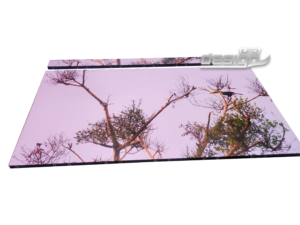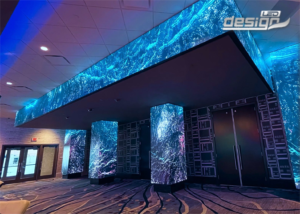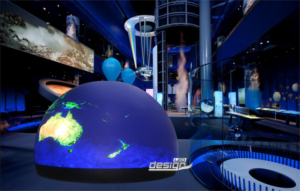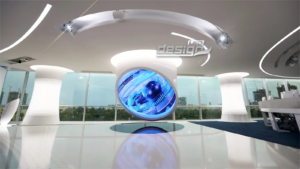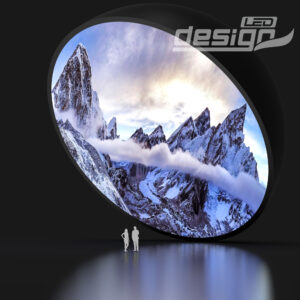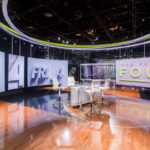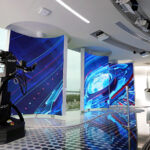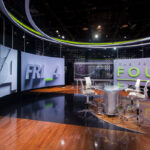An LED, or light-emitting diode, is a technology for display video, images, or text. It comprises a series of light-emitting diodes (LEDs) that emit light when an electric current is going through them. These displays distinguish themselves by their great brightness, vibrant colours, energy efficiency, and diversity in content display. Let us dive into the LED display installation.
Key Features of LED Displays
Display Structure
An LED display is a flat based panel display of small LEDs arranged in a grid or matrix pattern. Each LED acts as a pixel and emits light on its own. Pixels work together to produce the intended images, movies, or text.
Pixel Pitch
The gap between the centres of neighbouring pixels on the display is pixel pitch. Pixels are closer together with a lower pixel pitch, resulting in a better resolution and clearer image.
Resolution
The amount of pixels horizontally and vertically determines the resolution of an LED display. A 1920×1080 monitor, for example, has 1920 pixels in width and 1080 pixels in height.
Brightness
Brightness is an important characteristic of LED displays. LEDs can produce bright light, making LED displays suitable for indoor and outdoor use. The brightness is the number of nits or candelas per square metre (cd/m2).
Rate of Refresh
The refresh rate indicates how many times per second the image on the display is fresh—a faster refresh rate results in smoother motion and less flickering.
Angle of View
The viewing angle is the highest angle at which the display can see without substantial colour and brightness deterioration. A broad viewing angle guarantees that the content is viewable from all angles.
Colour Reproduction
Due to the multiple coloured LEDs (red, green, blue) utilized in each pixel, LED displays can reproduce a wide range of colours—this capacity to exhibit a wide range of colours results in rich, lifelike pictures.
Control System
LED displays manage by a system that manages the displayed content, adjusts brightness, controls power, and checks the display’s status. This system uses input devices such as PCs, media players, or specialized LED display controllers to control.
Installation
Installing an LED screen entails various procedures to ensure correct setup and performance. The following is a general guide to do an LED display installation:
Examine the installation area to find the best location for the LED screen. Ensure the LED screen has enough area, power, and structural support.
- Site Evaluation and Preparation
Examine the Installation Site
Begin by surveying the installation site thoroughly to locate the optimum location for the LED display installation. Consider visibility, foot traffic, viewing angles, and the intended audience.
Examine the surrounding environment, including lighting, temperature, rain, sunlight, or extreme weather exposure.
Space, electrical power, and structural support
Measure the available space and make sure it can support the size and arrangement of the LED display installation, taking width and height into account. Examine neighbouring power sources to see if they meet the LED screen’s power requirements.
Determine whether further electrical work or power distribution units will require. Examine the installation area’s structural integrity to ensure it can withstand the weight of the LED screen and mounting framework. If necessary, seek advice from a structural engineer.
Regulations and security
Learn about local building codes, permits, and requirements for LED display installations. Before installing, ensure compliance with safety requirements and secure any necessary approvals.
Prioritise safety precautions during the installation to protect workers and the general public.
Maintenance and Access
Make provisions for future maintenance and servicing at the installation site. Consider concerns such as technician accessibility, equipment transportation, and spare component storage.
Establish maintenance protocols and schedules to ensure the long-term operation and endurance of the LED screen.
Timetable and budget
Create a complete budget for the entire project, considering prices for equipment, installation, electrical work, permits, and any other requirements.
Make a realistic installation timeline that includes site preparation, equipment purchase, assembly, testing, and final installation.
Consultation with the Client
Please communicate with the client or stakeholders to ensure their needs and they will expect during the site evaluation and installation planning.
Address any concerns or special requirements they may have about the LED screen installation.
Thorough site evaluation and careful planning are essential for guaranteeing a successful LED screen installation that fits the project’s technical, aesthetic, and functional criteria.
Benefits of AmFlexPro LED Screen
High visibility and illumination
LED screens generally have great brightness levels, allowing them to see even in well-lit areas and outside. This guarantees that the displayed content remains clear and appealing.
Energy Conservation
LED technology is more energy-efficient than traditional display technologies, consuming less electricity. This can lead to cheaper operational costs and a smaller environmental footprint.
Display that is vivid and vibrant
LED displays are colourful and dynamic, with a wide colour spectrum. This makes them perfect for displaying multimedia material, resulting in a fascinating viewing experience.
Customization and adaptability
LED displays can be flexible or modular, allowing customized configurations to match different locations and requirements, depending on the unique product features. They are in various shapes to accommodate custom designs.
Longevity and durability
LED screens are durable and long-lasting, offering consistent performance over time. This lifespan equates to a favourable return on investment.
Clarity and high resolution
LED screens can have high resolutions, producing sharp and clear visuals whether they display text, photos, or movies. This is especially important for applications that require a high level of detail and clarity.
Content Management and Remote Control
Many LED screens, especially newer ones, include advanced control systems allowing remote management, real-time updates, and content scheduling. This simplicity of control and management improves efficiency and flexibility.
Various Applications
LED screens are for different purposes, such as advertising and marketing displays, information dissemination, entertainment at events and venues, way-finding, interactive displays, and more.
Conclusion
In conclusion, the AmFlexPro LED screen is a display technology highlight, providing colourful pictures with exceptional visibility even in well-lit areas. Its energy efficiency lowers operational expenses while also promoting sustainability. The screen’s versatility enables customized layouts to fit various places and purposes, ranging from advertising to interactive displays.
Meticulous installation, as indicated in the accompanying guide, is to maximize its potential and link it with specific project requirements. Finally, the AmFlexPro LED screen’s combination of remarkable qualities positions it as a top choice in modern display technology, efficiently and effectively serving various applications.
DesignLED is a global leader in LED display technology, specializing in the development, manufacturing, and distribution of high-quality, innovative LED display solutions. With a focus on MicroLED displays and immersive LED Dome experiences, DesignLED delivers cutting-edge products that cater to a wide range of industries, including broadcasting, digital signage, and entertainment. Committed to delivering unparalleled visual performance and energy efficiency, DesignLED strives to empower businesses and content creators with the tools to create stunning and engaging visual experiences.

